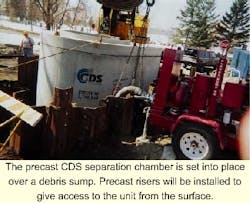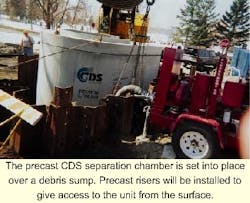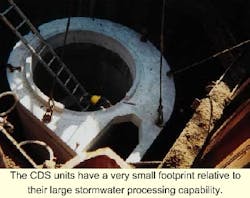Minneapolis Designs Plan to Improve Water Quality
Public officials and citizens of Minneapolis, MN, are very protective of their lakes and streams, so it came as no surprise that reaction was swift after the water quality in an urban lake began to deteriorate. Algae blooms in Lake Nokomis, a part of the Chain of Lakes in southwest Minneapolis, caused odor problems, killed beneficial fish, and reduced oxygen levels in the lake as the algae died. In addition, it gave the water an unappealing greyish-brown color and reduced its recreational value.
Studies showed the algae blooms were a result of excess phosphorous from fertilizer and decaying leaf and other lawn litter which washed into the lake with stormwater. The situation was made worse by the fact that stormwater emptied directly into the lake, without first being filtered through natural wetlands. Also, there was a large population of non-native, bottom-feeding carp stirring the sediment, preventing the phosphorous from settling out. In addition, a creek which drained out of the lake would sometimes backflow, bringing phosphorous-laden water back into the lake.
In 1997 the Nokomis East Neighborhood Association, working with the Minnehaha Creek Watershed District, formed a cooperative group called Blue Water Partnership to address water-quality problems in Lake Nokomis. The partnership included representatives from Minnehaha Creek Watershed District, City of Minneapolis Public Works Department, and Minneapolis Parks and Recreation Board.
The Minnehaha District decided on a five-part program to improve the water quality in Lake Nokomis. The plan was to remove the carp, build three wetland settlement ponds, add aluminum sulfate to the lake bottom, install an inflatable weir on the lake's outlet, and install two Continuous Deflection Separation (CDS) units. In 1999, HDR Engineering, (Minneapolis) was hired to complete the engineering design and to implement the plan.
Wetland Settlement Ponds
Three new wetland settlement ponds (named Amelia, Nokomis Knoll, and Gateway), totaling 8.2 acres, have been built at the south end of the lake to capture phosphorous and allow it to settle and become nutrients for the 55,000 hand-planted native wildflowers, grasses, and wetland plants which surround the ponds.
The ponds were designed to look natural, and were constructed without cutting existing trees. In a city consistently awarded for its beautiful parks and lake areas, aesthetics play just as important a role as the engineering mechanics of the pond. Engineering models indicate the project will remove over 900 pounds of phosphorous annually from the water entering the lake.
Inflatable Weir
An inflatable weir has been installed across the outlet of Lake Nokomis where it empties into Minnehaha Creek. At times, the water level in the creek rises faster than the lake. At those times, phosphorous loads are flushed upstream from the creek, back into the lake. The inflatable weir has sensors which monitor the water level in the creek. If the creek begins to rise above the level of the lake, the dam is automatically inflated to prevent any backflow.
Alum Treatment
Plans call for the lake to be treated with aluminum sulfate, a non-toxic chemical that binds with phosphorous, causing it to quickly settle to the lake bottom. A definite treatment date has not been set, and the decision may be postponed for at least a year. If the other actions achieve sufficient phosphorous reductions, the alum treatment may not be needed.
Storm Water Treatment
Two CDS units have been installed on outfalls where sufficient land was not available to incorporate settlement ponds and wetlands to handle the large flows involved. The units are generally cylindrical, underground structures which can be designed to treat flows as small as one million gallons per day (mgd) and up to 200 mgd. Flow is diverted from a storm sewer drain into a unit where the natural motion of water is used to screen and trap pollutants.
As water is diverted from a storm sewer into the separation chamber, the water begins a circular motion designed to allow it to pass through a cylindrical stainless steel screen while forcing pollutants to swirl toward the center of the chamber. The swirling flow is balanced to assure that the tangential flow around the chamber is always greater than the radial force attempting to push the pollutants outward. As a result, the screen will not block. Instead, it is continuously swept clean while floatables, grit, and other pollutants swirl in the center of the chamber. Heavier pollutants settle into a central sump where they can be removed by vacuum one to four times each year.
CDS units remove virtually 100 percent of floatables from stormwater. They also remove 100 percent of all particles that are greater than one-half the size of the screen opening. Standard screens are available from 4700 microns (0.185 inch) to 2400 microns (0.095 inch). Studies show the units remove 93 percent of all particles which are one-third the size of the screen opening, and 53 percent of all particles one-fifth that size.
A conventional oil baffle within the units controls oil and grease in stormwater. Studies have shown that with the addition of sorbents, the capture efficiency of free oil and grease is approximately 80-90 percent.
Project Specifications
The Minneapolis project required manufacturers of stormwater treatment systems, often referred to as grit chambers, to meet exacting performance specifications. In addition to fitting into the space available, treatment systems would have to reduce total suspended solids (TSS) in the stormwater by at least 42 percent, and reduce the annual phosphorous load released into the lake from the treated storm drain outfall by at least 12 percent. CDS Technologies, Inc., (Morgan Hill, CA) was able to exceed those specifications for the lowest total cost.
After the contract was awarded, a value engineering proposal by CDS Technologies was accepted to reduced the total number of installed units from four to two. Three grit chambers proposed on a single drain system were replaced by a single large-capacity unit, thus saving installation costs and minimizing the construction disruption in the neighborhood. The largest of the CDS units only required an excavation of 20 by 20 by 20 feet.
Installation
The prefabricated concrete separation units were installed by city crews during winter, so work was sometimes delayed because crews were occupied by emergency snow-removal or temperatures below 150 below zero. However, both units were installed within the six week scheduled.
The smaller unit serves an 18 inch diameter pipe which is on a 9 percent grade. It is capable of processing a flow of 1350 gpm before any bypassing can occur. The larger unit serves a 48 inch pipe and will process at least 11,500 gpm before bypassing any flow. These flow rates cover the vast majority of rain events which are expected to occur in the watershed.
Conclusion
Several major rain events have occurred since the water-quality work has been completed. Based on the performance of the projects at Lake Nokomis and at other lakes in the Minneapolis area, success is expected. The city has already drawn some conclusions about the success of the CDS technology and have decided to install five more grit chambers at another local lake.


